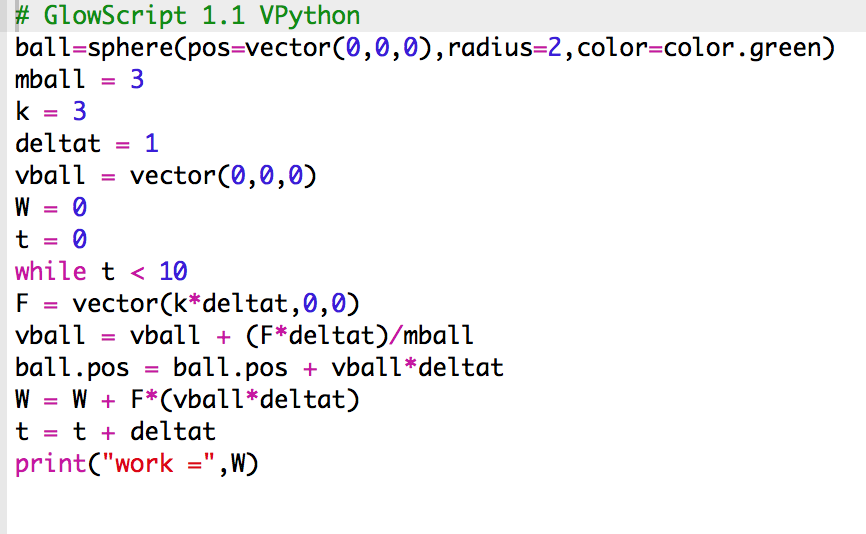Work Done By A Nonconstant Force
Claimed by Chris Mickas
This page will help students understand how to calculate the work done by a non constant force.
The Main Idea
When calculating the force, if the magnitude of the force or direction of the force changes, it is not possible to calculate the work done by multiplying force by the displacement. Instead the non constant force is split into a path with small increments.
A Mathematical Model
[math]\displaystyle{ W=\int\limits_{i}^{f}\overrightarrow{F}\bullet\overrightarrow{dr} = \sum\overrightarrow{F}\bullet\Delta\overrightarrow{r} }[/math]
This means that the work is equal to the integral of the function of the force with respect to the change in the objects position. This is also the same as the summation of the force on an object multiplied by the change in position.
A Computational Model
This python code creates a ball with a force acting on it that changes with respect to time and it prints the total work at the end of the the loop that lasts while t is less than 10. This uses the concept that work is equal to the summation of the force multiplied by the change in distance over that interval, which is an estimate for the integral of the force function over this distance.
Examples
Example 1
A box is pushed to the East, 5 meters by a force of 40 N, then it is pushed to the north 7 meters by a force of 60 N. Calculate the work done on the box.
[math]\displaystyle{ W = \sum\overrightarrow{F}\bullet\Delta\overrightarrow{r} }[/math]
[math]\displaystyle{ W = 40N \bullet\ 5m + 60N \bullet\ 7m }[/math]
[math]\displaystyle{ W = 40N \bullet\ 5m + 60N \bullet\ 7m }[/math]
[math]\displaystyle{ W = 620 J }[/math]
Example 2
As a ball is attached to a spring and moves to the right. The ball moves 5 meters to the right and the spring constant of the spring is 5 N/m. How much work is done by the spring?
[math]\displaystyle{ W=\int\limits_{i}^{f}\overrightarrow{F}\bullet\overrightarrow{dr} }[/math]
[math]\displaystyle{ F = -k \bullet\ r }[/math]
[math]\displaystyle{ W=\int\limits_{0}^{5m} -k \bullet\ dr }[/math]
[math]\displaystyle{ W=\int\limits_{0}^{5m} -5 \bullet\ dr }[/math]
[math]\displaystyle{ W=\int\limits_{0}^{5m} -5 \bullet\ dr }[/math]
[math]\displaystyle{ W=-5 ((5m^2)/2 - 0) }[/math]
[math]\displaystyle{ W= 62.5 J }[/math]
Connectedness
How is this topic connected to something that you are interested in?
Even though I'm an ECE major, I have an interest in aviation, and the force of a jet engine is not always a constant force, so you would need to use this method to calculate the work done instead of the simple method.
How is it connected to your major?
As an ECE major, this could be connected by my major when working with an electric motor and calculating the amount of power needed to power the motor.
Is there an interesting industrial application?
Since many forces in the real world are not constant, this method of calculating work is needed for most situations.
History
The concept of work was introduced by a French mathematician named Gaspard-Gustave Coriolis in 1826. The concept was established as a "weight lifted through a height".
See also
References
Created by Justin Vuong
